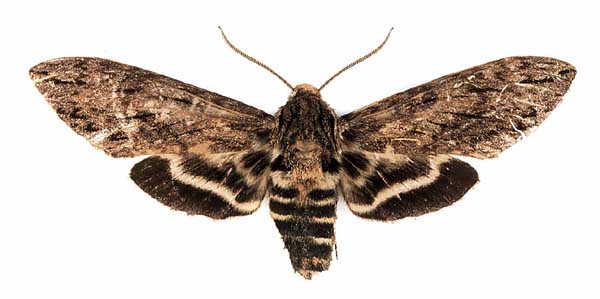|
|
Updated as per The Hawk Moths of the North America, 2007, James P. Tuttle (Sphinx to Lintneria); April 2009
Updated as per CATE; April 2009
Updated as per personal communication with James P. Tuttle (Costa Rica specimen collected 2008); April 2009
|
Lintneria biolleyi
(Schaus, 1912) Sphinx

Sphinx biolleyi courtesy of Dan Janzen.
This site has been created by
Bill Oehlke at oehlkew@islandtelecom.com
Comments, suggestions and/or additional information are welcomed by Bill.
TAXONOMY:
Family: Sphingidae, Latreille, 1802
Subfamily: Sphinginae, Latreille, 1802
Tribe: Sphingini, Latreille, 1802
Genus: Lintneria Butler, 1876 ...........
Species: biolleyi (Schaus, 1912)
|
MIDI MUSIC
.....It's a Wonderful World.....
copyright C. Odenkirk
ON.OFF
<bgsound src="world.mid" LOOP=FOREVER>
|
DISTRIBUTION:
Lintneria biolleyi
(Wing span: 90mm) flies in Costa Rica (possibly now extinct there; not so; specimen collected in Costa Rica 2008) and
Guatemala: Suchitepequez; Sacatepequez; Huehuetenango; Baja Verapaz.
"The holotype specimen from Costa Rica is the only
Costa Rican specimen known (extinct?), photograph courtesy of I.
Kitching at The Natural History Museum (London), compare with
Sphinx merops found throughout lowland Costa Rica,
Sphinx biolleyi apparently occurs in Guatemala as a breeding
population."
A specimen was taken in mountains near San Jose, Costa Rica in 2008.
"Similar to Lintneria lugens, but differing in the details of pattern.
"Frons brown, vertex brown, shaded black posteriorly; collar black dorsally, laterally edged with a black line that continues to
the tips of the patagia, and with a lateral brown and white colouration. Patagia and thorax upperside reddish brown, mottled
with a few whitish scales.Abdomen upperside with a basal light brown tuft, with subdorsal black spots, and with
alternating broad black and narrow white bands; two dorsal grey lines diverge and broaden towards the anal segments.
"Palpi brown, fringed with white basally. Abdomen underside white, with black ventral points.
"Forewing upperside brown, speckled with pale buff; a basal, double antemedian, median and postmedian angled black spots along the
costa; black and white tufts at the base of the hind margin; an antemedian patch of pinkish buff scales posterior to the
discal cell, cut by a fine black line; discal cell with a black streak, produced beyond the cell; black intervenosal streaks
posterior to veins M1, M3 CuA1; a convex postmedian fuscous band, with distal to it an indistinct, fine, fuscous, dentate line; a
convex series of submarginal, angled, black lines between the veins; black apical line to vein M1, interrupted at vein Rs4; some
small marginal black spots.
"Hindwing upperside largely black, with a antemedial whitish line curving basad at costal and hind margins, and a sinuous white
postmedian band; fringe white, spotted with black." CATE
In his The Hawk Moths of North America, 2007, James P. Tuttle has assigned all the
Sphinx genus species from Mexico south throughout South American to Lintneria, Butler, 1876, based on
consistent differences in wing characters and significant larval differences.
FLIGHT TIMES:
Lintneria biolleyi adults fly in April-May in Guatemala.
ECLOSION:
Pupae probably wiggle to surface from subterranean chambers just prior to eclosion.
SCENTING AND MATING:
Females call in the males with a pheromone released from a gland at the tip of the
abdomen. Adults probably nectar at a variety of flowers.
EGGS, LARVAE, PUPAE:
Please visit my special request for images of Lintneria species larvae at
Lintneria larvae, and help if you can.
It is anticipated that the Lintneria larvae will most often be encountered on Lamiaceae: Salvia (Sage), Mentha (Mints), Monarda (Beebalm) and
Hyptis (Bushmints); Verbenaceae: Verbena and Lantana camara (shrub verbenas or lantanas).
Although they may be encountered feeding during daylight hours, one is even more likely to discover them feeding in the evening or after dark.
Two of the greatest clues for discovering larvae are stripped foliage and droppings beneath the plant. You might be quite surprised at what will turn up in the evening or
after dark in a flashlight assisted search.
It is believed that all "Lintneria larvae will exhibit "a fleshy thoracic dorsal "horn" in the first 4 instars (unique in the Sphingidae of the world to my
knowledge) which is replaced by a thoracic dorsal "hump" with a large black patch in the 5th instar." J.A. Tuttle.
Return to U.S.A. Table
Return to Sphingidae Index
Return to Sphingini Tribe
Use your browser "Back" button to return to the previous page.
This page is brought to you by
Bill Oehlke and the
WLSS. Pages are on space rented from Bizland. If you would like
to become a "Patron of the Sphingidae Site", contact Bill.
Please send sightings/images to Bill. I will do my best to respond to
requests for identification help.
Enjoy one of nature's wonderments: Live
Saturniidae (Giant Silkmoth) cocoons.
 | 
Show appreciation for this site by clicking on flashing butterfly to the left.
The link will take you to a page with links to many insect sites. |


